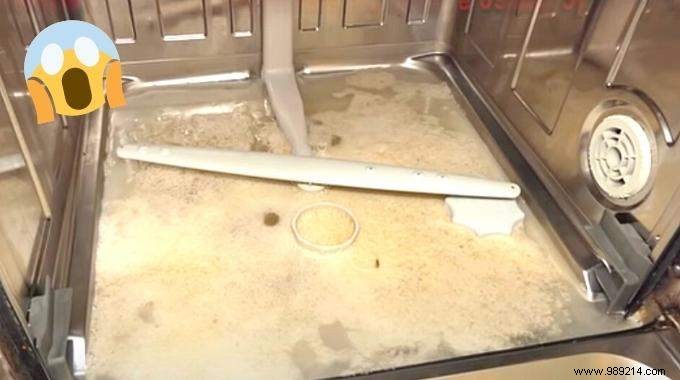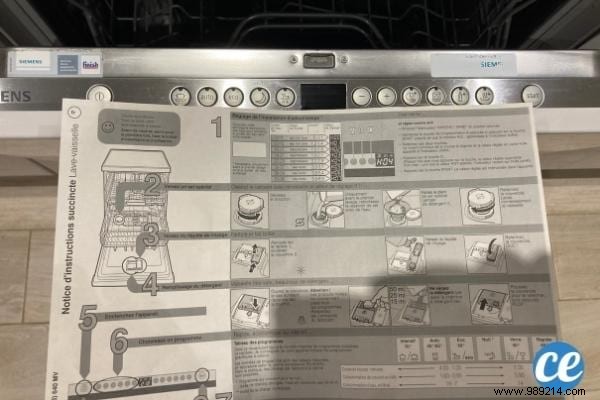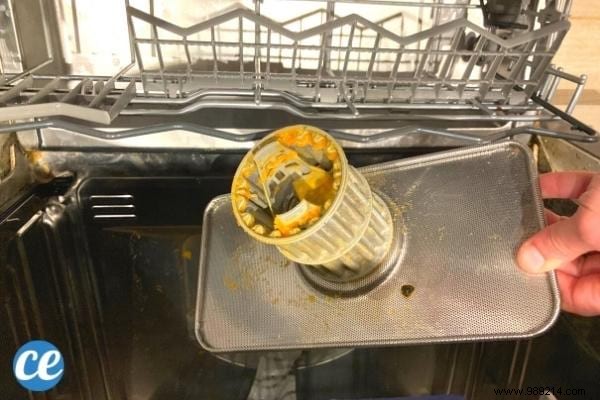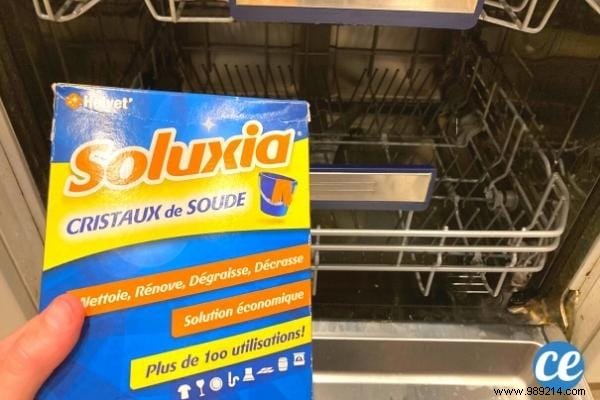
There is standing water in the bottom of your washing machine. washing up ?
Worse, you saw water coming out in the middle of the wash cycle!?
It's probably because your machine is clogged.
Suddenly, a little surprised, you are not sure how to react and call yourself a repairman.
Stop spending your money right away! Know that unclogging a dishwasher is not very difficult.
You just need to know how to go about it. And I know how to do it...
It was my plumber friend who explained everything to me.
Discoverthe 6 tips for quickly and easily unclogging a dishwasher. Watch:


Before explaining to you how to unclog a dishwasher, there are a few steps you must follow.
Already, for security reasons, unplug your machine.
Then shut off the water supply to prevent flooding.
Finally, before any intervention on the parts, the cloudy water which stagnates at the bottom of the appliance must be emptied into the sink.
Use a sponge for this rather than a cup or a ladle, as these utensils could scratch the surface.
Protect your floors with a mop during the operation so that there is no water everywhere.
Once these first steps have been completed, you can continue.

So it may not be revolutionary, but looking at the instructions for use of a dishwasher is absolutely necessary.
Do you know why?
Because this type of device, especially the most recent ones, is full of electronics.
This on-board electronics allows the dishwasher to tell you where the problem is.
And usually the diagnosis is pretty well done.
Mine (I have a Samsung) for example displays error codes on the screen.
I then refer to the user manual which explains to me what the anomaly corresponds to.
For a clogged dishwasher, it is often at the level of the evacuation parts that the problems come from.
So let's see how.

The first thing to do to unclog a dishwasher is to tackle the filter.
Finally when I say attack, it means to clean it well.
Because very often, it is this centerpiece that is the problem.
It is there to prevent food residues from entering the pipes during the washing cycle.
So imagine everything that fits in this filter as you use the dishwasher.
It's full of grease and small residues of all kinds.
But you know what, cleaning the filter is not complicated at all.
Just follow these few steps:
First, unscrew the filter by turning it clockwise.
Then remove the rack from the bottom of the dishwasher.
Scrub the filter and the grid with a simple kitchen brush by running hot water over them.
Remove and discard any leftover food.
Once the filter and the grid have been thoroughly cleaned, all you have to do is put them back in place.
Run a short, empty wash cycle and you should be fine.
If not, move on to the next trick.

Cleaning the filter is sometimes not enough to completely unclog the dishwasher.
The drain hose may also be completely clogged.
In this case, it is not very complicated to take care of it either.
Find where the hose is and take it out of its location (it is usually at the back of the dishwasher).
Put the outlet of the hose in a basin, as water may leak out.
If impurities are present inside, pass a broomstick through it or a ferret.
The handle allows you to push all the residues out and thus to unclog the pipe.
Reposition it and run a short wash cycle on empty.

If the hot water still hasn't blocked the drain, another natural solution can be used.
You can use soda crystals, well known for dissolving greasy residue.
In a container filled with hot water, pour 4 tablespoons of soda crystals.
This creates a paste that needs to be spread on the bottom of the dishwasher, where the filter is.
Also put some on the spray arms.
Leave to rest for 10 minutes and run a short program without load.
The soda crystals work effectively in the pipes to unclog them.
Ah yes last thing.
Soda crystals are used for many things, and in particular to make your own dishwasher tablets!
Think about it.
Another 100% natural and effective technique is to use white vinegar and baking soda.
In a container, pour 200g of baking soda, 20 cl of white vinegar and 200g of salt.
When you make the vinegar/bicarbonate mixture, a chemical reaction (emulsion) will take place.
Do not panic; this is completely normal and harmless.
Pour the solution directly into the cavity of the dishwasher (where the filter is located) and leave to act for 30 min.
Then pour boiling water to thoroughly clean the pipes.
You have thoroughly cleaned the filter and the drain hose and yet the problem is still not solved?
This is probably because the clog is further down the drain.
We must then find other tricks to unclog all that.
But above all, no need to use chemicals like Destop which pollutes a lot.
I show you how to do it with totally natural products.
And what could be more natural than simply using water, more precisely boiling water?
It sounds basic, but it's terribly effective.
Because the very hot water melts the stubborn grease accumulated in the pipes.
Boil a large pot of water and remove the filter and grill from the appliance.
Pour all the liquid into the hole to break up any residue.
To avoid having a clogged dishwasher, certain precautions must be taken.
First and quite logically, do not leave food residues in your dishes and plates.
So I didn't say wash them before putting them in the dishwasher.
Besides, be aware that doing this reduces the effectiveness of the cleaning tablets.
However, don't leave half-cut pasta on your plate!
We put it all in the trash.
Also remember to remove the labels stuck on the glass jars.
These small papers can clog the filter and prevent water from draining.
Also, don't put anything in the machine, it could damage your device.
Finally, do a short, empty washing cycle from time to time by applying this trick.
There you go, you now know how to easily unclog a dishwasher.
Easy, fast and efficient, right?
Plus, it works on all brands.
Siemens, Beko, Brandt, Bosch, Arthur Martin, Continental, Electrolux, Thomson, Whirlpool, Mièle...
You see, no need to hire an expensive plumber.
With these tips, your dishwasher will be unclogged in no time.